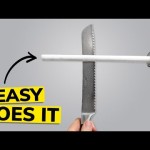Sharpening a knife is an essential skill for any home cook or chef. A sharp knife is not only safer to use, but it also makes cutting and slicing easier and more precise. While there are many ways to sharpen a knife, using a stone is the best way to get a razor-sharp edge. In this article, we will discuss the basics of sharpening a knife with a stone, including the types of stones, the sharpening process, and the importance of maintaining a sharp knife.
Why can’t I get a razor edge on my knife
Getting a razor edge on a knife is a skill that takes practice and patience. It requires the right tools and techniques to achieve a sharp, clean edge. Unfortunately, many people struggle to get a razor edge on their knives, no matter how hard they try.
The most common reason why people can’t get a razor edge on their knives is because they don’t use the right sharpening tools. A sharpening stone is the best tool for sharpening a knife, as it allows you to control the angle of the blade and the pressure applied. If you don’t have a sharpening stone, you can use a honing steel or a sharpening rod, but these tools are not as effective as a sharpening stone.
Another reason why people can’t get a razor edge on their knives is because they don’t use the right technique. Sharpening a knife requires a consistent angle and pressure, and it’s important to use a back-and-forth motion when sharpening. If you don’t use the right technique, you won’t be able to get a sharp edge.
Finally, some knives are simply too dull to get a razor edge. If your knife is too dull, you may need to use a more aggressive sharpening technique, such as using a diamond sharpening stone or a belt sander. These tools can help you get a sharper edge, but they can also damage the blade if used incorrectly.
Getting a razor edge on a knife is a skill that takes practice and patience. With the right tools and techniques, you can get a sharp, clean edge on your knife. If you’re having trouble getting a razor edge, make sure you’re using the right tools and techniques, and if your knife is too dull, consider using a more aggressive sharpening technique.
What grit for razor-sharp
Sharpening a blade is an important part of maintaining a knife, axe, or other cutting tool. The process of sharpening involves grinding away material from the blade to create a sharp edge. The coarseness of the grinding material, or grit, is an important factor in determining the sharpness of the blade.
The grit of a sharpening stone is measured in numbers, with higher numbers indicating finer grit. A lower grit stone is more coarse and will remove more material from the blade, while a higher grit stone is finer and will create a sharper edge. Generally, a blade should be sharpened with a stone of at least 1000 grit for a razor-sharp edge.
When sharpening a blade, it is important to start with a lower grit stone and work up to a higher grit. This will ensure that the blade is properly sharpened and that the edge is even. Starting with a higher grit stone can result in an uneven edge and a blade that is not as sharp as it could be.
Once the blade has been sharpened with a 1000 grit stone, it can be honed with a higher grit stone. A stone of 3000-5000 grit is usually sufficient for honing a blade. This will create a very sharp edge that will last for a long time.
Sharpening a blade is an important part of maintaining a cutting tool. The grit of the sharpening stone is an important factor in determining the sharpness of the blade. For a razor-sharp edge, a blade should be sharpened with a stone of at least 1000 grit and honed with a stone of 3000-5000 grit.
Do you push or pull a blade with a sharpening stone
Sharpening a blade with a sharpening stone is a great way to keep your blades in top condition. But when it comes to the actual sharpening process, there is some debate about whether you should push or pull the blade across the stone.
Pushing vs. Pulling
When it comes to sharpening a blade with a sharpening stone, there are two main techniques: pushing and pulling. Pushing involves pushing the blade away from you, while pulling involves pulling the blade towards you.
Pros and Cons of Pushing
Pushing a blade across a sharpening stone has some advantages. It is easier to control the angle of the blade, and it is easier to keep the blade in contact with the stone. However, pushing can also be more difficult to do, as it requires more strength and can be tiring.
Pros and Cons of Pulling
Pulling a blade across a sharpening stone has some advantages as well. It is easier to keep the blade in contact with the stone, and it is easier to maintain a consistent angle. However, it can be more difficult to control the angle of the blade, and it can be more difficult to keep the blade in contact with the stone.
Conclusion
Ultimately, the decision of whether to push or pull a blade with a sharpening stone is up to the individual. Both techniques have their advantages and disadvantages, and it is important to consider both before deciding which technique is best for you.
How do you make a knife sharp with a stone
Sharpening a knife with a stone is a simple process that requires a few basic tools. It is important to use the correct type of stone for the type of knife you are sharpening. The most common type of stone used for sharpening knives is a whetstone, which is a flat, rectangular stone with a coarse side and a fine side.
To begin sharpening your knife, you will need to wet the stone with water. This will help to create a slurry, which is a mixture of water and stone particles that will help to sharpen the blade. Once the stone is wet, you can begin to sharpen the knife.
Start by placing the knife on the coarse side of the stone and pushing it away from you at a 20-degree angle. Make sure to keep the angle consistent throughout the sharpening process. You should then draw the knife across the stone in a back-and-forth motion, making sure to apply even pressure. After a few strokes, you can flip the knife over and repeat the process on the other side.
Once you have finished sharpening the knife on the coarse side of the stone, you can move on to the fine side. This side of the stone will help to refine the edge of the blade and make it even sharper. The same technique should be used on the fine side of the stone, but with less pressure.
Once you have finished sharpening the knife on the stone, you should rinse it off with water and dry it with a cloth. This will help to remove any particles that may have been left behind. You should also check the blade for any burrs or nicks that may have been created during the sharpening process.
Sharpening a knife with a stone is a simple process that can help to keep your knives in top condition. With a little practice, you can easily learn how to sharpen a knife with a stone and keep your blades sharp and ready for use.
We hope this article has been helpful in teaching you the best way to sharpen a knife with a stone. With a little practice, you’ll be able to get a razor-sharp edge in no time!
Thank you for reading, and goodbye!















